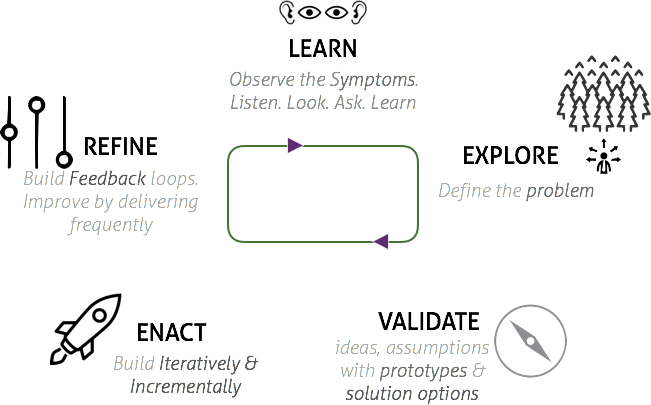Design Thinking has gained a lot of traction these days, and rightly so – with it being seen as having the potential for companies to create value for their clients better.
While Design Thinking is not a new term – the reasons for its recent prominence (apart from news that large companies are adopting them) may be worth a discussion.
Our interactions at a societal level are changing rapidly due to the rapid ubiquity of technology. The effect of this seems to be playing out at two levels
- Existing businesses that have thrived in the pre-digital paradigms are scrambling to present a coherent response to this technology ubiquity, and continue being relevant in their customer’s worlds. The challenges that these businesses face to even start responding are many – from getting stakeholders internally aligned and primed for action; to , the bigger challenge of making sense of their customer’s needs and wants.
- New businesses are emerging – A world of new platforms and services capitalising on this technology ubiquity and people’s willingness to use it. They compete for the space that existing businesses find difficulty moving in to.
This applies to any segment of business – retail, transportation, banking, energy, entertainment or education.
It is in this context that Design Thinking has become more prominent. Design Thinking provides an way to understand the context of a problem before actually trying to define the problem and solving it. It helps us slow down and still go faster (in my opinion – by eliminating wasteful actions).
Hence, Design Thinking provides a structure to figure out the challenges for existing and new businesses to understand their customers better and move forward to cater to their customers.
There are two popular models of Design Thinking: IDEO’s Human Centric Design, which provides a structure for people to think about innovation from the lenses of Desirability, Viability and Feasibility. And, British Design Council’s Double diamond approach; a diverge-converge paradigm to find causes before settling on a specific problem to solve, and adopting a similar cycle to generate ideas before converging on the concept model.
While these models have their place, it will be useful to simplify Design Thinking as a habit of our life.
Design Thinking is better thought of as a LEVER for us to do things better, to Innovate¹
An advantage of considering Design Thinking as an Innovation LEVER is that it clarifies what Design Thinking actually is – and what it is not.
Design Thinking provides a structure – for individuals and teams to look closely at challenges, understand the problem before moving to create a solution. Hence, practising Design Thinking will also need tools and skills required to use the structure effectively.
Each step of creating a response has tools that have been used for ages. Tools for research, for generating ideas, to validate assumptions and to build solutions incrementally while getting constant feedback.
Effective use of this structure requires multiple skills – a strength that only a poly-skilled team can bring in. It is critical to build facilitation skills for effective collaboration across teams and stakeholders with these skills and knowledge.
Without these tools and the collaboration skills, the structure that Design Thinking provides will end up being procedural – risking Design Thinking being tagged as a fad.
In subsequent posts, I plan to write about:
- Important ingredients to start adopting Design Thinking Practicies – Structure, Skills and Tools
- The relevance of Design Thinking, Agile and DevOps in the lifecycle of businesses (are they the Three musketeers of innovation?)
- Challenges in looking for and creating innovation when teams are distributed.
- Introducing Design Thinking in to teams – and in existing environments.
I will greatly appreciate you writing and responding on this post – to further me on the learning path.
¹innovate: make changes in something established, especially by introducing new methods, ideas, or products





